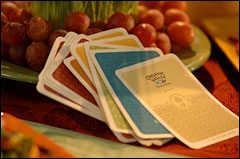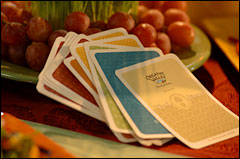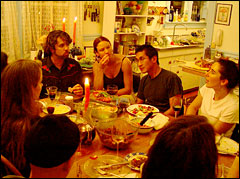This is the third installment in a series about connecting with friends and family over specific meals; the first was an introduction to dining co-ops, the second a celebration of Passover.
At a recent dinner party, I pulled out my deck of Earth Dinner cards. The first one asked, “Who in your life really understands how to make the food you love?” Two raisin-hating men at the table tenderly cited their mothers’ willingness to provide raisinless cuisine on their behalf. One of their wives, who is raisin-positive, just rolled her eyes.

Deal or no deal?
Photo: iStockphoto
The next card asked if we knew the names of any of the farmers who produced our food. Some of us belong to CSAs and knew the name of the farm, but not the farmers, while others (like me) recognize the faces of the farmers from whom we buy produce at the farmers’ market but don’t know their names. Some of us get produce from the gardens of friends and family in addition to whatever we grow ourselves.
A third card quizzed us on the correct price for Kopi Luwak, the world’s most expensive coffee. I aced this one. (One of the occupational hazards of being a food writer is that one’s gray matter is completely used up by useless food knowledge.) I was surprised that the card didn’t explain why the coffee is so expensive, but then I remembered the process behind this rare commodity. Let’s just say it’s not a topic for the dinner table.
We went through a few more questions, which inspired conversations we couldn’t have predicted before the meal began. And that’s exactly the point of the growing Earth Dinner tradition. It began in 2003 as an effort to create an Earth Day event that people could celebrate in their homes or with others. And the cards — bearing recipes, food facts, trivia, and questions about the memories and connections to food experienced by those eating it — can bring a new element to any meal, holiday or not.
The Origins of the Earth Dinner
To find out how Earth Dinners and their cards came to be, I called Organic Valley, the farmer-owned cooperative that’s currently the project’s main sponsor. I was referred to Theresa Marquez, the company’s chief marketing officer.
Marquez is one of a group of people who helped to come up with the idea for Earth Dinners. She says it all started when several people who had been working in the natural-foods industry for over 25 years got together and talked about the fact that most people aren’t aware of where their food comes from or the impact that agriculture and production have on the environment. They also talked about the fact that Americans eat a large portion of their meals in cars or in front of the TV, spending little time actually sitting at a table, paying attention to their food and conversing with each other. The group envisioned Earth Dinners as a tradition that would focus on two goals: identifying a meal’s origins and sharing stories.
Marquez told me about the beta versions of Earth Dinners, where organizers would ask between six and a dozen people for dinner, tell stories, and brainstorm ideas. She was moved, sometimes to tears, by some of the stories people told, especially older people; one remembered only being able to afford lard sandwiches during childhood. “Even sad memories and memories of scarcity are precious,” Marquez noted.
The dinners proved to be a way to celebrate happy memories as well, such as eating yogurt with fresh-picked cherries while growing up in Greece. To keep such conversations rolling, Douglas Love, an award-winning author and TV producer, was commissioned to write the cards, which were designed by Lindsey, Stone, and Briggs of Madison, Wis.
Love’s goal, he says, was to create “fun and lighthearted activities and story starters that would engage adults and kids.” Although he wrote 48 cards, he found that at most early trial dinners, groups got through only about seven. “They sparked so much sharing and conversation that we now hear from Earth Dinner hosts around the country that they pull out the cards on a regular basis and it’s always a fresh experience,” he says. “I have learned more about the people in my life and myself through [this] process.”
Groups including Heifer International have used Earth Dinners as fundraisers, and some corporations have used them to help strengthen their company culture. Now 16 partners have joined the project, including Chefs Collaborative, Children’s Health Environmental Coalition, Bioneers, Environmental Working Group, Slow Food USA, the Organic Consumers Association, and the Waterkeeper Alliance.
Marquez said that, without wanting to sound immodest, she hopes one day Earth Dinners will help Earth Day to become a more celebrated national holiday — giving everyone a chance to gather with their friends and family and talk over a good meal.
The Recipe
The Earth Dinner website offers recipes donated by chefs from all over the country. Organic Valley also offers more than 300 recipes, all with nutritional content listed.
Here’s a recipe of my own that I think is perfect for an early spring dinner party.
Spring Vegetable Platter with a Vegetarian Bagna Cauda Sauce
A traditional bagna cauda is a sort of vegetable fondue (the phrase means “warm bath”). You start with a platter of raw or barely blanched vegetables, then dip them in a warm sauce made of butter, olive oil, garlic, and anchovies. I decided to try using sun-dried tomato paste as a substitute for the anchovies, thinking that it would still add a savory flavor to the sauce, and it does. (Someday I am also going to try using just a tad of balsamic vinegar or some kind of mustard to see what happens.) Also, rather than use only raw or blanched vegetables, I added some roasted asparagus and string beans, hard-boiled eggs, boiled red potatoes, roasted red peppers, canned chickpeas, marinated artichoke hearts, and goat cheese. Finally, I served the sauce in a small pitcher so guests could pour the amount they wanted over their individual portions. You end up using less sauce (and less fat) that way. That’s why I call this a vegetable platter rather than a classic bagna cauda.
Rather than give amounts to make a specific number of servings, I’ll give a formula you can use to adapt for the number of people who will be attending. This is a vegetarian main dish: the hard-boiled eggs and chickpeas provide the protein. It’s quick and easy to make, but you will need to grill, roast, or steam the asparagus; roast, steam, or microwave the green beans; boil the potatoes; and hard-boil the eggs. These are all things you can do ahead of time, which makes things easier.
This is the formula for one serving; multiply by the number of people you will serve:
3 spears medium asparagus or 6 spears of skinny asparagus
5-7 haricots verts (skinny string beans) or regular string beans
olive oil for roasting the asparagus and string beans
salt and freshly ground black pepper for the asparagus and string beans
1 hard-boiled egg, shelled
7 cherry tomatoes, halved or 1 small tomato, quartered
2 small red potatoes, boiled, cooled, and quartered
1-2 ounces goat cheese
1-2 pieces of roasted red pepper (from a jar is fine)
1-2 tablespoons cooked chickpeas (well rinsed if from a can)
2 marinated artichoke hearts
1 tablespoon lightly toasted walnuts
Obviously, if you think your guests will be hungrier, add more — if not, use less.
To make the platter:
- Hard-boil the eggs. Shell the eggs only a short while before serving. Slice the eggs in half lengthwise right before plating the salad.
- Steam, grill, or roast the asparagus. Wash and dry the asparagus and cut off ends that are too fibrous. Before grilling or roasting, toss the asparagus in olive oil and then sprinkle lightly with salt and freshly ground black pepper. Grill or roast until thoroughly tender but not too charred, or steam until tender.
- Boil the potatoes. Let cool completely and then slice into quarters.
- Wash, dry, and roast the green beans after putting olive oil and salt and pepper on them just as with the asparagus, or you can boil, steam, or microwave the beans until completely tender. If you’ve boiled, steamed, or microwaved the beans, “shock” them by plunging them into ice-cold water to preserve their color. If you’ve roasted them, leave them as they are.
- If using canned chickpeas, rinse them thoroughly and, if you like, warm them gently in a pot of simmering water. Do not cook them! You are just aiming to warm them until they are slightly tender and can’t remember that they were ever in a can. (“The last thing I remember, I was in a beautiful garden …”)
- Slice the tomatoes.
- Slice the roasted red peppers into long strips.
- Cut the goat cheese into discs.
Assembling the salad:
You can serve the salad on a large platter to be passed around or make individual servings. If serving on a large platter, it’s nice to make an arrangement where half of each kind of vegetable is on either end of the plate. It doesn’t need to be perfectly symmetrical, but it’s nicer than having all the vegetables clumped together by type.
Vegetarian Bagna Cauda Sauce
3/4 cup olive oil
6 tablespoons unsalted butter at room temperature
1/2 teaspoon sun-dried tomato paste
4 garlic cloves, peeled and minced
salt
freshly ground black pepper
1/2 teaspoon fresh lemon juice, if needed
Blend the olive oil, butter, sun-dried tomato paste, and garlic in a food processor or blender until thoroughly blended. Warm gently over low heat. The oil and butter will separate, but that’s OK. Take it off the heat and then season to taste with salt and pepper. If you think it needs a little bit more “brightness,” squeeze the lemon juice in at the last minute. Pour this sauce into a small pitcher to pass around for the guests to pour onto their vegetables. This should make enough to go over 4-6 servings.



